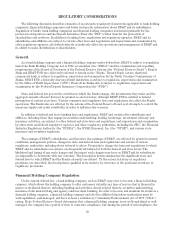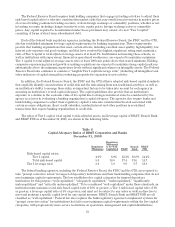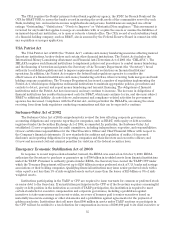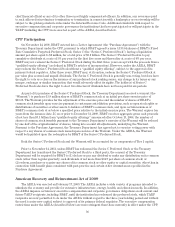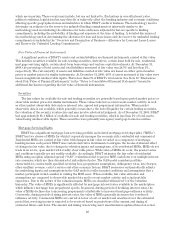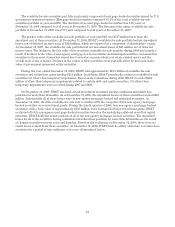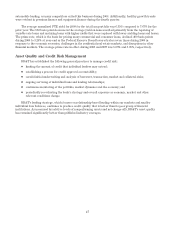BB&T 2008 Annual Report Download - page 37
Download and view the complete annual report
Please find page 37 of the 2008 BB&T annual report below. You can navigate through the pages in the report by either clicking on the pages listed below, or by using the keyword search tool below to find specific information within the annual report.but it is yet unclear how these executive compensation standards will relate to the similar standards recently
announced by the Treasury Department, or whether the standards will be considered effective immediately or
only after implementing regulations are issued by the Treasury Department.
The ARRA amends Section 111 of the EESA to require the Secretary to adopt additional standards with
respect to executive compensation and corporate governance for TARP recipients (including BB&T). The
standards required to be established by the Secretary include, in part, (1) prohibitions on making golden
parachute payments to senior executive officers and the next 5 most highly-compensated employees during such
time as any obligation arising from financial assistance provided under the TARP remains outstanding (the
“Restricted Period”), (2) prohibitions on paying or accruing bonuses or other incentive awards for certain senior
executive officers and employees, except for awards of long-term restricted stock with a value equal to no greater
than 1/3 of the subject employee’s annual compensation that do not fully vest during the Restricted Period or
unless such compensation is pursuant to a valid written employment contract prior to February 11, 2009,
(3) requirements that TARP CPP participants provide for the recovery of any bonus or incentive compensation
paid to senior executive officers and the next 20 most highly-compensated employees based on statements of
earnings, revenues, gains or other criteria later found to be materially inaccurate, with the Secretary having
authority to negotiate for reimbursement, and (4) a review by the Secretary of all bonuses and other
compensation paid by TARP participants to senior executive employees and the next 20 most highly-
compensated employees before the date of enactment of the ARRA to determine whether such payments were
inconsistent with the purposes of the Act.
The ARRA also sets forth additional corporate governance obligations for TARP recipients, including
requirements for the Secretary to establish standards that provide for semi-annual meetings of compensation
committees of the board of directors to discuss and evaluate employee compensation plans in light of an
assessment of any risk posed from such compensation plans. TARP recipients are further required by the ARRA
to have in place company-wide policies regarding excessive or luxury expenditures, permit non-binding
shareholder “say-on-pay” proposals to be included in proxy materials, as well as require written certifications by
the chief executive officer and chief financial officer with respect to compliance. The Secretary is required to
promulgate regulations to implement the executive compensation and certain corporate governance provisions
detailed in the ARRA.
Federal Deposit Insurance Corporation
Pursuant to the EESA, the maximum deposit insurance amount per depositor has been increased from
$100,000 to $250,000 until December 31, 2009. Additionally, on October 14, 2008, after receiving a recommendation
from the boards of the FDIC and the Federal Reserve, and consulting with the President, the Secretary of the
Treasury signed the systemic risk exception to the FDIC Act, enabling the FDIC to establish its Temporary
Liquidity Guarantee Program (“TLGP”). Under the transaction account guarantee program of the TLGP, the
FDIC will fully guarantee, until the end of 2009, all non-interest-bearing transaction accounts, including NOW
accounts with interest rates of 0.5 percent or less and IOLTAs (lawyer trust accounts). The TLGP also
guarantees all senior unsecured debt of insured depository institutions or their qualified holding companies issued
between October 14, 2008 and June 30, 2009 with a stated maturity greater than 30 days. All eligible institutions
were permitted to participate in both of the components of the TLGP without cost for the first 30 days of the
program. Following the initial 30 day grace period, institutions were assessed at the rate of ten basis points for
transaction account balances in excess of $250,000 for the transaction account guarantee program and at the rate
of either 50, 75, or 100 basis points of the amount of debt issued, depending on the maturity date of the
guaranteed debt, for the debt guarantee program. Institutions were required to opt-out of the TLGP if they did
not wish to participate. BB&T did not choose to opt out of either the transaction account guarantee program or
debt guarantee program components of the TGLP.
Future Laws, Regulations and Governmental Programs
Various laws, regulations and governmental programs affecting financial institutions and the financial
industry are from time to time introduced in Congress or otherwise promulgated by regulatory agencies. Such
measures may change the operating environment of BB&T and its subsidiaries in substantial and unpredictable
37





